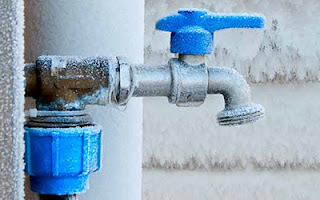One of the most stressful problems for any homeowner to deal with is a burst pipe and the resulting water damage that goes along with it. Even less than a few millimeters of water can cause great damage to your home and your belongings. Frozen pipes, a common plumbing issue in the wintertime, can easily burst if not properly thawed out.
The water damage restoration experts at INSPECT IT ALL SERVICES want everyone to be familiar with how to prevent and how to deal with water damage resulting from burst pipes.
The most easily recognized sign of a frozen pipe is if only a small trickle of water comes out when you turn on a faucet. You should be able to locate the frozen pipe by inspecting the pipes along your exterior walls. It'll be the one covered in ice!
Frozen pipes can be thawed in numerous ways in order to prevent water damage in your home. Using a hair dryer or a heating pad are probably your two best options for melting the ice. Wrapping hot towels around the pipe can also help, as can placing a space heater nearby. You'll want to keep the faucet open while trying any of these strategies, as the running water can further help thaw out the pipe.
If you find the frozen pipe only to see that it has already burst or has a crack in it, then you need to turn off the water and call a plumber right away. You should also get in touch with a plumber if you're unable to access the frozen pipe, or if none of your efforts at thawing it out seem to be working.
Furthermore, if the bust pipe had already resulted in water damage, then your next step is to remove the water. Using towels, mops, buckets, or whatever you have available, try to soak up as much of the water as you can. The flooded area must be dried and disinfected, or it can become a hotbed of mold and bacteria growth. You'll also need to go through your belongings and figure out which items unfortunately need to be thrown out.
Complete water damage restoration is best left up to the professionals who have the tools and expertise for the job. If you try to take care of everything yourself, you'll likely miss spots of moisture and won't be able to tell which belongings you should no longer keep in your home.
INSPECT IT ALL SERVICES can help you get everything back in good shape after a burst pipe causes water damage in your home. We'll make sure that all excess moisture is removed and that everything is properly cleaned, disinfected, and dried. We can also help identify any damaged belongings that you should catalog for insurance purposes.
You can call INSPECT IT ALL SERVICES immediately at 1-306-540-6832 (24/7) if you have a water damage emergency.
The water damage restoration experts at INSPECT IT ALL SERVICES want everyone to be familiar with how to prevent and how to deal with water damage resulting from burst pipes.
The most easily recognized sign of a frozen pipe is if only a small trickle of water comes out when you turn on a faucet. You should be able to locate the frozen pipe by inspecting the pipes along your exterior walls. It'll be the one covered in ice!
Frozen pipes can be thawed in numerous ways in order to prevent water damage in your home. Using a hair dryer or a heating pad are probably your two best options for melting the ice. Wrapping hot towels around the pipe can also help, as can placing a space heater nearby. You'll want to keep the faucet open while trying any of these strategies, as the running water can further help thaw out the pipe.
If you find the frozen pipe only to see that it has already burst or has a crack in it, then you need to turn off the water and call a plumber right away. You should also get in touch with a plumber if you're unable to access the frozen pipe, or if none of your efforts at thawing it out seem to be working.
Furthermore, if the bust pipe had already resulted in water damage, then your next step is to remove the water. Using towels, mops, buckets, or whatever you have available, try to soak up as much of the water as you can. The flooded area must be dried and disinfected, or it can become a hotbed of mold and bacteria growth. You'll also need to go through your belongings and figure out which items unfortunately need to be thrown out.
Complete water damage restoration is best left up to the professionals who have the tools and expertise for the job. If you try to take care of everything yourself, you'll likely miss spots of moisture and won't be able to tell which belongings you should no longer keep in your home.
INSPECT IT ALL SERVICES can help you get everything back in good shape after a burst pipe causes water damage in your home. We'll make sure that all excess moisture is removed and that everything is properly cleaned, disinfected, and dried. We can also help identify any damaged belongings that you should catalog for insurance purposes.
You can call INSPECT IT ALL SERVICES immediately at 1-306-540-6832 (24/7) if you have a water damage emergency.


Comments
Post a Comment